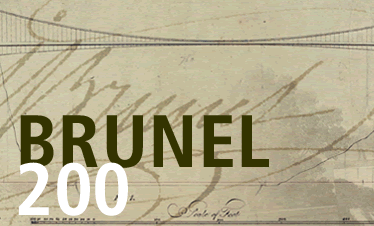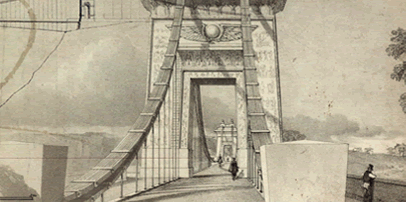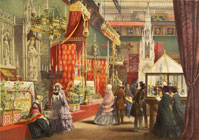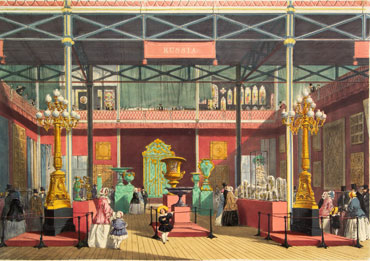


Medieval court, Great Exhibition
(Elton Collection: Ironbridge Gorge
Museum Trust)






Art
and Industry
In 1851, six million people visited The Great Exhibition of the Works
of Science and Industry of all Nations held in the Crystal Palace, a magnificent
purpose-built construction of glass and iron designed by Joseph Paxton.
Brunel was on the organising committee for the exhibition. All 245 entries
in a competition to design an exhibition space were rejected and Brunel
joined the building sub-committee, which came up with an extraordinarily
ugly brick-built structure with a squat, sheet-iron dome. The public outcry
that broke out when pictures of the design were released led to calls
to move the exhibition site further out of London, a proposal only narrowly
beaten in the Commons. Promoter Henry Cole encouraged Paxton, who had
not entered the original competition, to submit his own design. A ‘sneak
preview’ was shown in the Illustrated London News of 6 July and
a week later was formally approved by the committee.
The exhibition was said to have been originally proposed by Prince Albert
and aimed to promote and celebrate the achievements of the Industrial
Revolution. More than 100,000 exhibits were on show, organised into four
categories: raw materials, machinery, manufactured goods, and fine arts.
In addition to the international collection on display there were organised
events, including the popular organ concerts, and the fountains in and
around the Crystal Palace created a spectacular water feature, with the
jets reaching heights of 250 feet. Special excursion trains were organised
to bring in visitors from outside the city. The exhibition and the extraordinary
Palace constructed to house it symbolised for many the triumph of the
industrial age, a marker of the rise of technological innovation and of
globalisation. Furthermore, the exhibition profits supported the foundation
of new public museums, such as the Science Museum, Natural History Museum
and V&A in Kensington.
Prince Albert had wanted to demonstrate through the exhibition that industrialisation
could produce beautiful as well as useful goods, and the exhibits included
a considerable variety of arts and crafts. For many, the most beautiful
work of art on view was the Crystal Palace itself. However, some remained
unconvinced that the artistic could co-exist with the industrialised.
Key among these were the members of the Arts and Crafts movement and in
particular its founder Williams Morris. Morris, a socialist and member
of the pre-Raphaelite Brotherhood, rejected mass production in the same
way he rejected social injustice, feeling the two were inextricably linked.
In 1861, he founded a design company that created a range of products
(wallpaper, furniture, tiles, stain glass, silver work, fabrics) using
traditional techniques and handcrafting. Ironically, the designs proved
so popular they were copied by manufacturers and mass-produced.
With the closing of the Great Exhibition, the Crystal Palace was dismantled
and re-erected at Sydenham Hill. It was reopened on 10 June 1854 by Queen
Victoria and became what might be termed a Victorian theme-park, popularly
known as the Palace of the People. Brunel designed two water towers, each
carrying 3,000 tons of water, for the new site.

Russian displays, Great Exhibition: Dickinson Brothers lithograph
(Elton
Collection: Ironbridge Gorge Museum Trust)
